An In-Depth Analysis of the Relationship Between Brain, Mind, and Body
VerifiedAdded on 2023/06/18
|8
|2167
|210
Report
AI Summary
This report delves into the intricate relationship between the brain, mind, and body, exploring evidence linking personality aspects to brain activities, particularly focusing on the five-factor model and resting-state brain activity. It further examines working memory, discussing decay, resource, and interface theories, alongside neuropsychological case studies that highlight the role of the frontal cortex and synaptic weight changes in memory maintenance. The report also addresses attention, covering selective attention, experimental research on object priming, and neuropsychological perspectives, including the role of the brain stem and frontal lobes in attention functions. This comprehensive analysis provides insights into cognitive processes and their neural underpinnings.
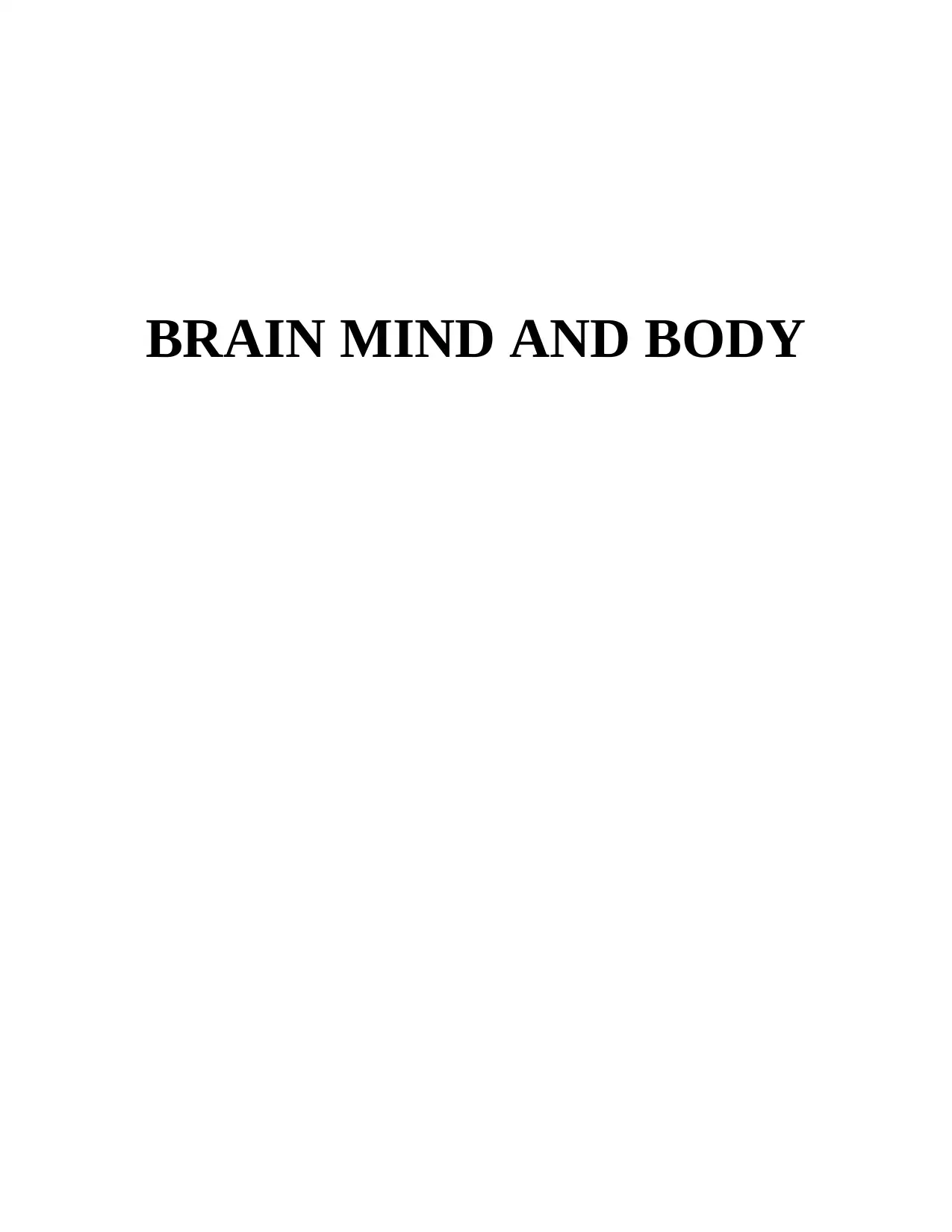
BRAIN MIND AND BODY
Paraphrase This Document
Need a fresh take? Get an instant paraphrase of this document with our AI Paraphraser
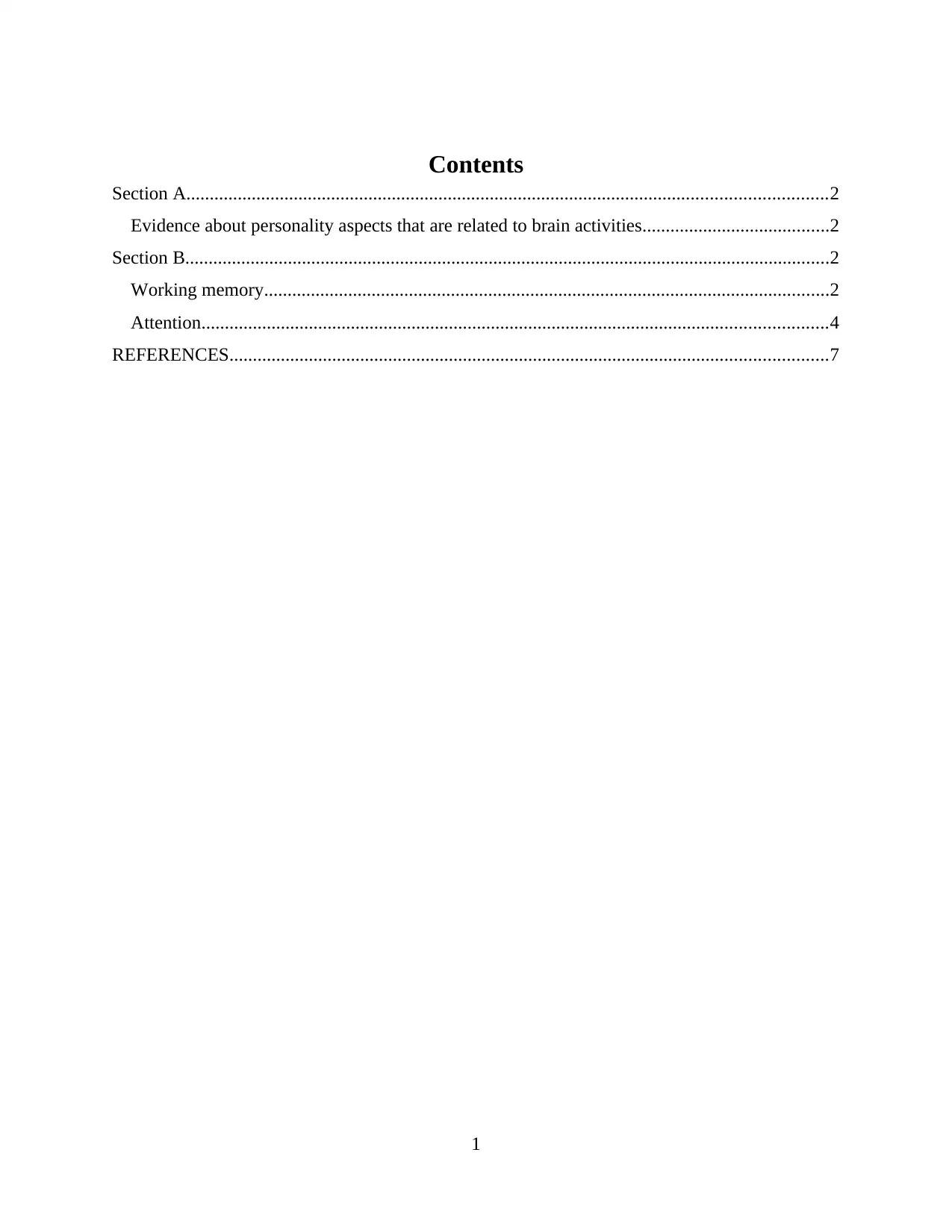
Contents
Section A.........................................................................................................................................2
Evidence about personality aspects that are related to brain activities........................................2
Section B..........................................................................................................................................2
Working memory.........................................................................................................................2
Attention......................................................................................................................................4
REFERENCES................................................................................................................................7
1
Section A.........................................................................................................................................2
Evidence about personality aspects that are related to brain activities........................................2
Section B..........................................................................................................................................2
Working memory.........................................................................................................................2
Attention......................................................................................................................................4
REFERENCES................................................................................................................................7
1
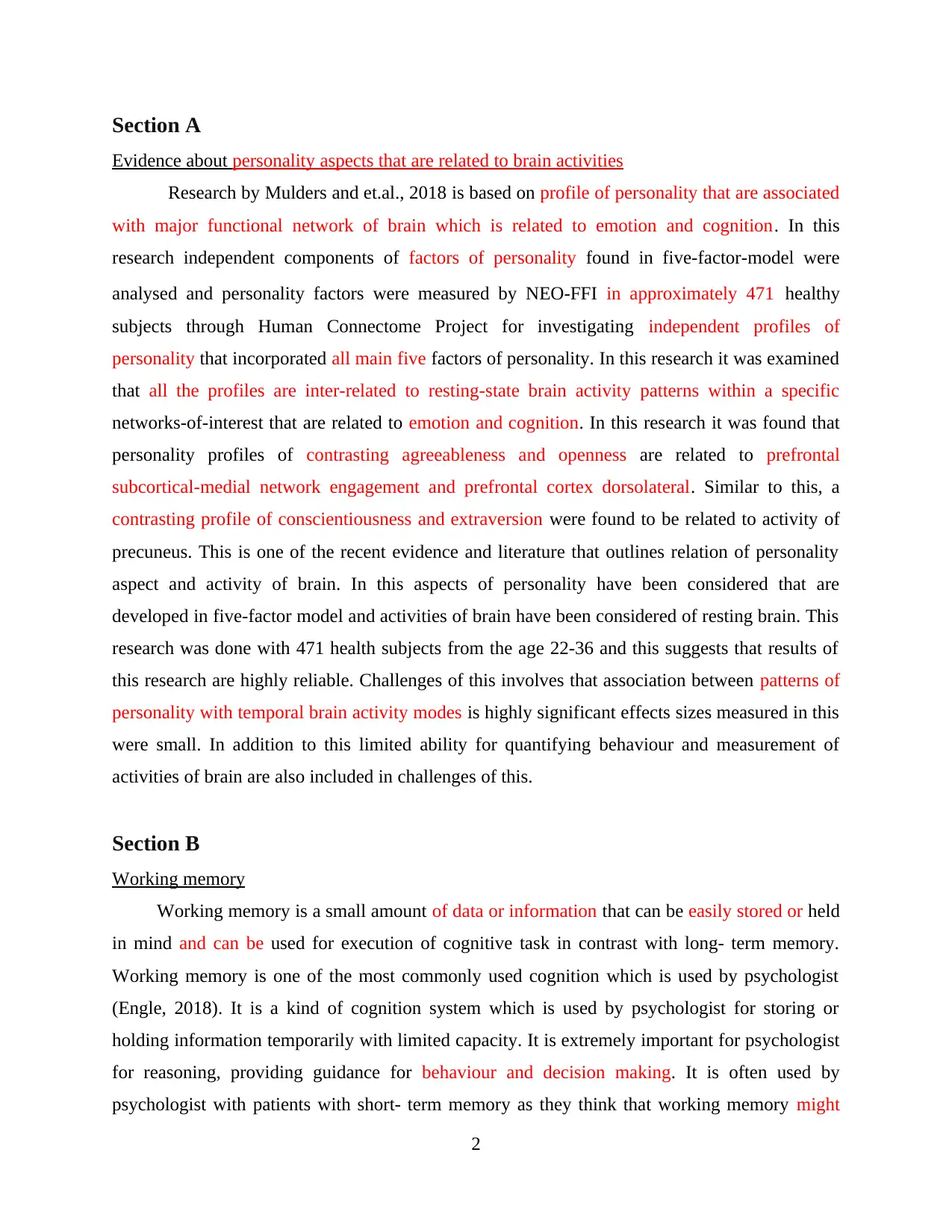
Section A
Evidence about personality aspects that are related to brain activities
Research by Mulders and et.al., 2018 is based on profile of personality that are associated
with major functional network of brain which is related to emotion and cognition. In this
research independent components of factors of personality found in five-factor-model were
analysed and personality factors were measured by NEO-FFI in approximately 471 healthy
subjects through Human Connectome Project for investigating independent profiles of
personality that incorporated all main five factors of personality. In this research it was examined
that all the profiles are inter-related to resting-state brain activity patterns within a specific
networks-of-interest that are related to emotion and cognition. In this research it was found that
personality profiles of contrasting agreeableness and openness are related to prefrontal
subcortical-medial network engagement and prefrontal cortex dorsolateral. Similar to this, a
contrasting profile of conscientiousness and extraversion were found to be related to activity of
precuneus. This is one of the recent evidence and literature that outlines relation of personality
aspect and activity of brain. In this aspects of personality have been considered that are
developed in five-factor model and activities of brain have been considered of resting brain. This
research was done with 471 health subjects from the age 22-36 and this suggests that results of
this research are highly reliable. Challenges of this involves that association between patterns of
personality with temporal brain activity modes is highly significant effects sizes measured in this
were small. In addition to this limited ability for quantifying behaviour and measurement of
activities of brain are also included in challenges of this.
Section B
Working memory
Working memory is a small amount of data or information that can be easily stored or held
in mind and can be used for execution of cognitive task in contrast with long- term memory.
Working memory is one of the most commonly used cognition which is used by psychologist
(Engle, 2018). It is a kind of cognition system which is used by psychologist for storing or
holding information temporarily with limited capacity. It is extremely important for psychologist
for reasoning, providing guidance for behaviour and decision making. It is often used by
psychologist with patients with short- term memory as they think that working memory might
2
Evidence about personality aspects that are related to brain activities
Research by Mulders and et.al., 2018 is based on profile of personality that are associated
with major functional network of brain which is related to emotion and cognition. In this
research independent components of factors of personality found in five-factor-model were
analysed and personality factors were measured by NEO-FFI in approximately 471 healthy
subjects through Human Connectome Project for investigating independent profiles of
personality that incorporated all main five factors of personality. In this research it was examined
that all the profiles are inter-related to resting-state brain activity patterns within a specific
networks-of-interest that are related to emotion and cognition. In this research it was found that
personality profiles of contrasting agreeableness and openness are related to prefrontal
subcortical-medial network engagement and prefrontal cortex dorsolateral. Similar to this, a
contrasting profile of conscientiousness and extraversion were found to be related to activity of
precuneus. This is one of the recent evidence and literature that outlines relation of personality
aspect and activity of brain. In this aspects of personality have been considered that are
developed in five-factor model and activities of brain have been considered of resting brain. This
research was done with 471 health subjects from the age 22-36 and this suggests that results of
this research are highly reliable. Challenges of this involves that association between patterns of
personality with temporal brain activity modes is highly significant effects sizes measured in this
were small. In addition to this limited ability for quantifying behaviour and measurement of
activities of brain are also included in challenges of this.
Section B
Working memory
Working memory is a small amount of data or information that can be easily stored or held
in mind and can be used for execution of cognitive task in contrast with long- term memory.
Working memory is one of the most commonly used cognition which is used by psychologist
(Engle, 2018). It is a kind of cognition system which is used by psychologist for storing or
holding information temporarily with limited capacity. It is extremely important for psychologist
for reasoning, providing guidance for behaviour and decision making. It is often used by
psychologist with patients with short- term memory as they think that working memory might
2
⊘ This is a preview!⊘
Do you want full access?
Subscribe today to unlock all pages.

Trusted by 1+ million students worldwide
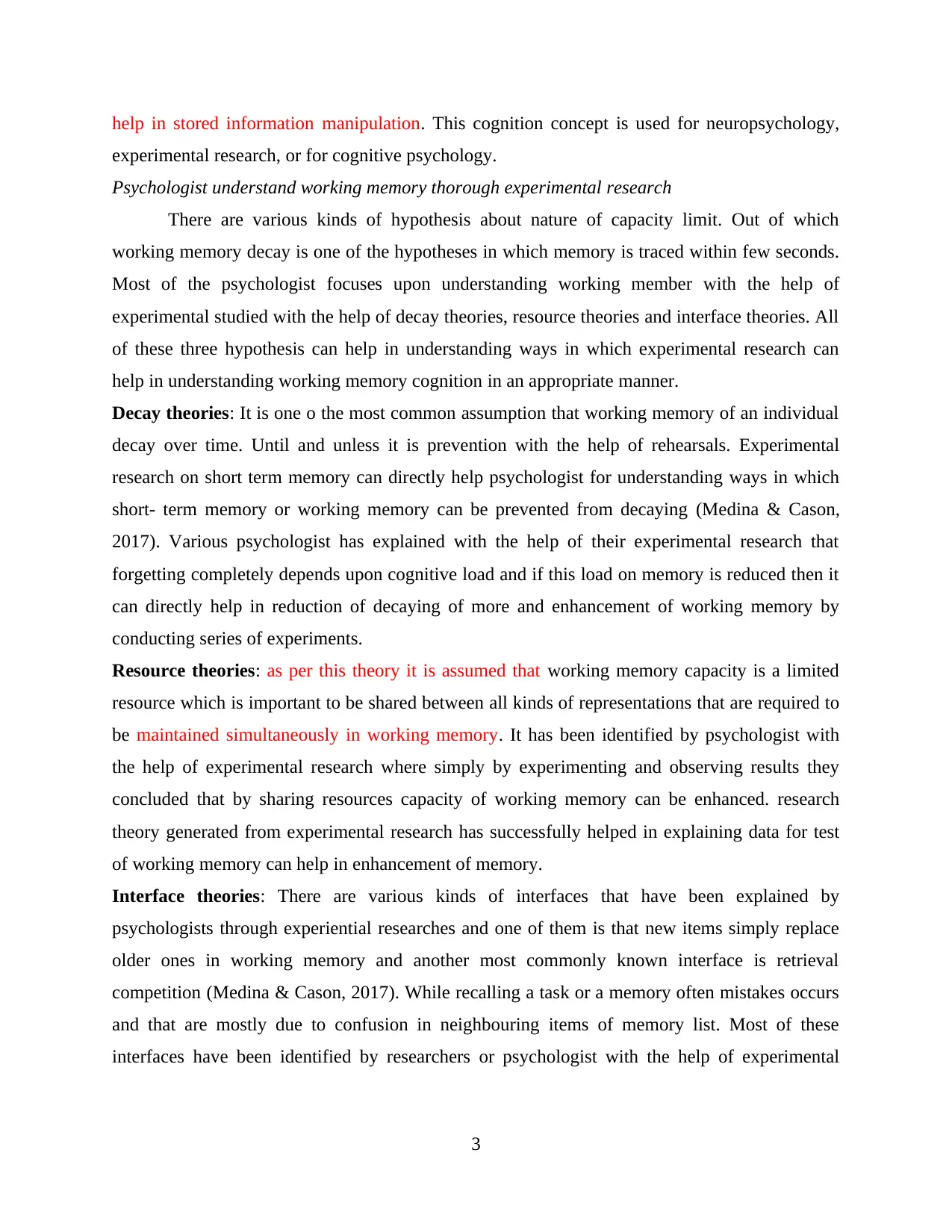
help in stored information manipulation. This cognition concept is used for neuropsychology,
experimental research, or for cognitive psychology.
Psychologist understand working memory thorough experimental research
There are various kinds of hypothesis about nature of capacity limit. Out of which
working memory decay is one of the hypotheses in which memory is traced within few seconds.
Most of the psychologist focuses upon understanding working member with the help of
experimental studied with the help of decay theories, resource theories and interface theories. All
of these three hypothesis can help in understanding ways in which experimental research can
help in understanding working memory cognition in an appropriate manner.
Decay theories: It is one o the most common assumption that working memory of an individual
decay over time. Until and unless it is prevention with the help of rehearsals. Experimental
research on short term memory can directly help psychologist for understanding ways in which
short- term memory or working memory can be prevented from decaying (Medina & Cason,
2017). Various psychologist has explained with the help of their experimental research that
forgetting completely depends upon cognitive load and if this load on memory is reduced then it
can directly help in reduction of decaying of more and enhancement of working memory by
conducting series of experiments.
Resource theories: as per this theory it is assumed that working memory capacity is a limited
resource which is important to be shared between all kinds of representations that are required to
be maintained simultaneously in working memory. It has been identified by psychologist with
the help of experimental research where simply by experimenting and observing results they
concluded that by sharing resources capacity of working memory can be enhanced. research
theory generated from experimental research has successfully helped in explaining data for test
of working memory can help in enhancement of memory.
Interface theories: There are various kinds of interfaces that have been explained by
psychologists through experiential researches and one of them is that new items simply replace
older ones in working memory and another most commonly known interface is retrieval
competition (Medina & Cason, 2017). While recalling a task or a memory often mistakes occurs
and that are mostly due to confusion in neighbouring items of memory list. Most of these
interfaces have been identified by researchers or psychologist with the help of experimental
3
experimental research, or for cognitive psychology.
Psychologist understand working memory thorough experimental research
There are various kinds of hypothesis about nature of capacity limit. Out of which
working memory decay is one of the hypotheses in which memory is traced within few seconds.
Most of the psychologist focuses upon understanding working member with the help of
experimental studied with the help of decay theories, resource theories and interface theories. All
of these three hypothesis can help in understanding ways in which experimental research can
help in understanding working memory cognition in an appropriate manner.
Decay theories: It is one o the most common assumption that working memory of an individual
decay over time. Until and unless it is prevention with the help of rehearsals. Experimental
research on short term memory can directly help psychologist for understanding ways in which
short- term memory or working memory can be prevented from decaying (Medina & Cason,
2017). Various psychologist has explained with the help of their experimental research that
forgetting completely depends upon cognitive load and if this load on memory is reduced then it
can directly help in reduction of decaying of more and enhancement of working memory by
conducting series of experiments.
Resource theories: as per this theory it is assumed that working memory capacity is a limited
resource which is important to be shared between all kinds of representations that are required to
be maintained simultaneously in working memory. It has been identified by psychologist with
the help of experimental research where simply by experimenting and observing results they
concluded that by sharing resources capacity of working memory can be enhanced. research
theory generated from experimental research has successfully helped in explaining data for test
of working memory can help in enhancement of memory.
Interface theories: There are various kinds of interfaces that have been explained by
psychologists through experiential researches and one of them is that new items simply replace
older ones in working memory and another most commonly known interface is retrieval
competition (Medina & Cason, 2017). While recalling a task or a memory often mistakes occurs
and that are mostly due to confusion in neighbouring items of memory list. Most of these
interfaces have been identified by researchers or psychologist with the help of experimental
3
Paraphrase This Document
Need a fresh take? Get an instant paraphrase of this document with our AI Paraphraser
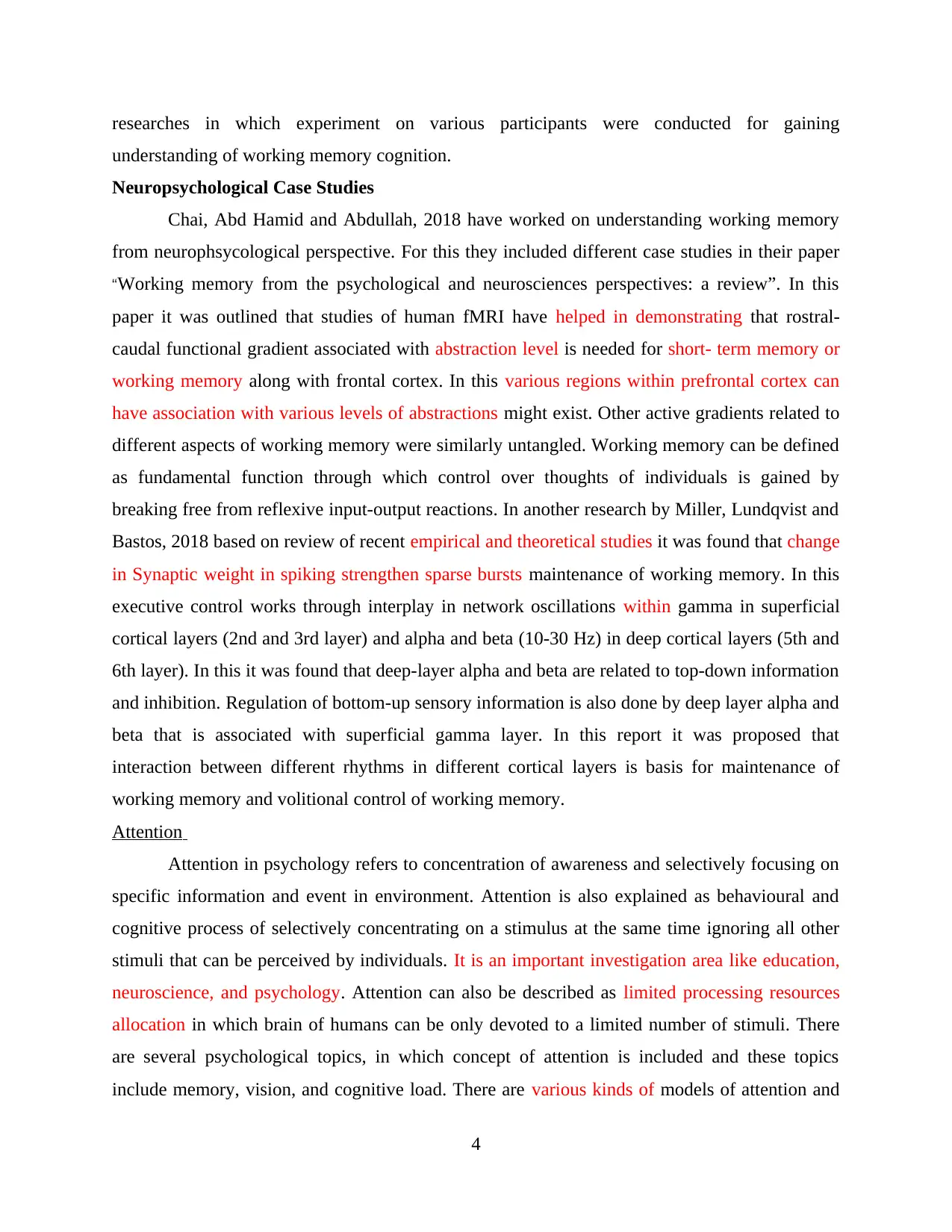
researches in which experiment on various participants were conducted for gaining
understanding of working memory cognition.
Neuropsychological Case Studies
Chai, Abd Hamid and Abdullah, 2018 have worked on understanding working memory
from neurophsycological perspective. For this they included different case studies in their paper
“Working memory from the psychological and neurosciences perspectives: a review”. In this
paper it was outlined that studies of human fMRI have helped in demonstrating that rostral-
caudal functional gradient associated with abstraction level is needed for short- term memory or
working memory along with frontal cortex. In this various regions within prefrontal cortex can
have association with various levels of abstractions might exist. Other active gradients related to
different aspects of working memory were similarly untangled. Working memory can be defined
as fundamental function through which control over thoughts of individuals is gained by
breaking free from reflexive input-output reactions. In another research by Miller, Lundqvist and
Bastos, 2018 based on review of recent empirical and theoretical studies it was found that change
in Synaptic weight in spiking strengthen sparse bursts maintenance of working memory. In this
executive control works through interplay in network oscillations within gamma in superficial
cortical layers (2nd and 3rd layer) and alpha and beta (10-30 Hz) in deep cortical layers (5th and
6th layer). In this it was found that deep-layer alpha and beta are related to top-down information
and inhibition. Regulation of bottom-up sensory information is also done by deep layer alpha and
beta that is associated with superficial gamma layer. In this report it was proposed that
interaction between different rhythms in different cortical layers is basis for maintenance of
working memory and volitional control of working memory.
Attention
Attention in psychology refers to concentration of awareness and selectively focusing on
specific information and event in environment. Attention is also explained as behavioural and
cognitive process of selectively concentrating on a stimulus at the same time ignoring all other
stimuli that can be perceived by individuals. It is an important investigation area like education,
neuroscience, and psychology. Attention can also be described as limited processing resources
allocation in which brain of humans can be only devoted to a limited number of stimuli. There
are several psychological topics, in which concept of attention is included and these topics
include memory, vision, and cognitive load. There are various kinds of models of attention and
4
understanding of working memory cognition.
Neuropsychological Case Studies
Chai, Abd Hamid and Abdullah, 2018 have worked on understanding working memory
from neurophsycological perspective. For this they included different case studies in their paper
“Working memory from the psychological and neurosciences perspectives: a review”. In this
paper it was outlined that studies of human fMRI have helped in demonstrating that rostral-
caudal functional gradient associated with abstraction level is needed for short- term memory or
working memory along with frontal cortex. In this various regions within prefrontal cortex can
have association with various levels of abstractions might exist. Other active gradients related to
different aspects of working memory were similarly untangled. Working memory can be defined
as fundamental function through which control over thoughts of individuals is gained by
breaking free from reflexive input-output reactions. In another research by Miller, Lundqvist and
Bastos, 2018 based on review of recent empirical and theoretical studies it was found that change
in Synaptic weight in spiking strengthen sparse bursts maintenance of working memory. In this
executive control works through interplay in network oscillations within gamma in superficial
cortical layers (2nd and 3rd layer) and alpha and beta (10-30 Hz) in deep cortical layers (5th and
6th layer). In this it was found that deep-layer alpha and beta are related to top-down information
and inhibition. Regulation of bottom-up sensory information is also done by deep layer alpha and
beta that is associated with superficial gamma layer. In this report it was proposed that
interaction between different rhythms in different cortical layers is basis for maintenance of
working memory and volitional control of working memory.
Attention
Attention in psychology refers to concentration of awareness and selectively focusing on
specific information and event in environment. Attention is also explained as behavioural and
cognitive process of selectively concentrating on a stimulus at the same time ignoring all other
stimuli that can be perceived by individuals. It is an important investigation area like education,
neuroscience, and psychology. Attention can also be described as limited processing resources
allocation in which brain of humans can be only devoted to a limited number of stimuli. There
are several psychological topics, in which concept of attention is included and these topics
include memory, vision, and cognitive load. There are various kinds of models of attention and
4
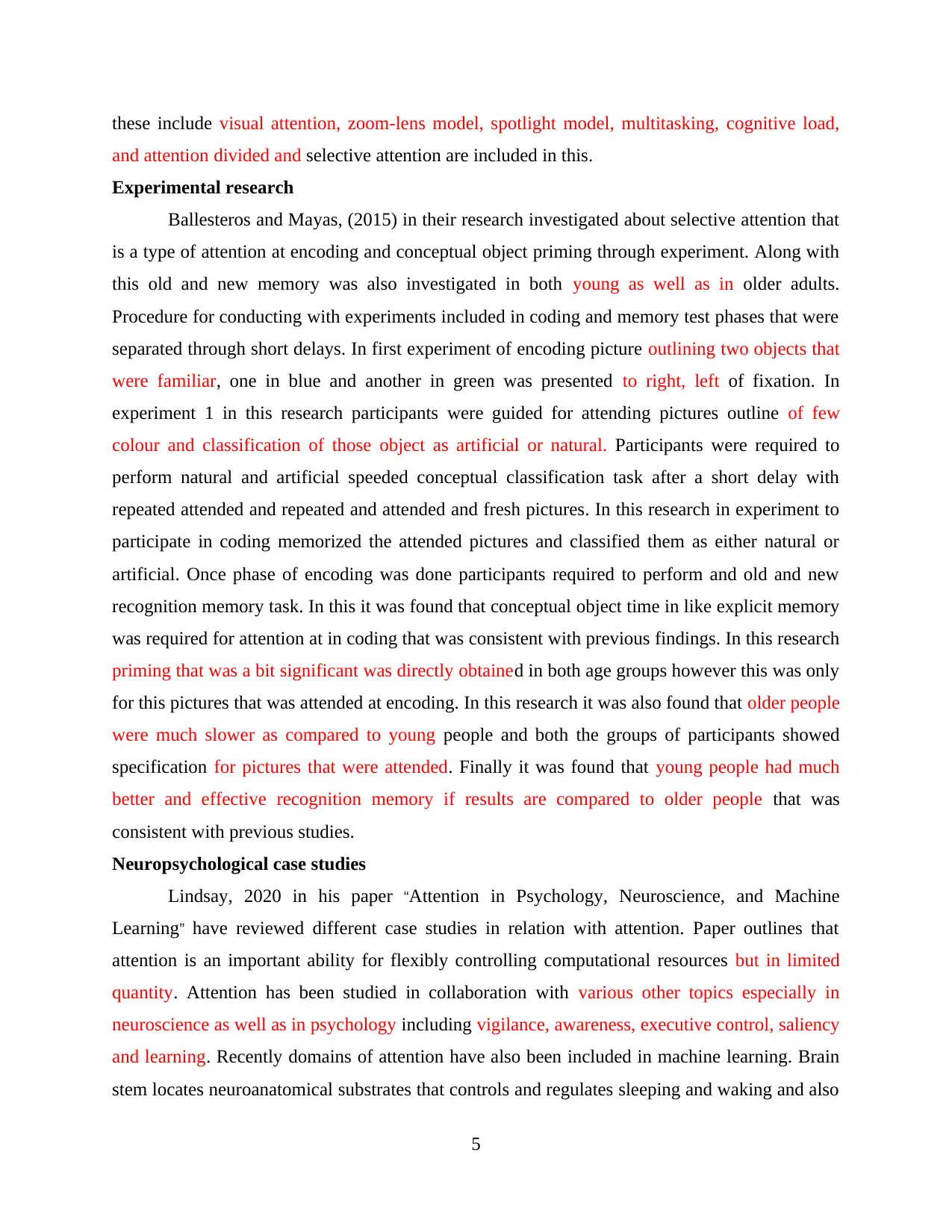
these include visual attention, zoom-lens model, spotlight model, multitasking, cognitive load,
and attention divided and selective attention are included in this.
Experimental research
Ballesteros and Mayas, (2015) in their research investigated about selective attention that
is a type of attention at encoding and conceptual object priming through experiment. Along with
this old and new memory was also investigated in both young as well as in older adults.
Procedure for conducting with experiments included in coding and memory test phases that were
separated through short delays. In first experiment of encoding picture outlining two objects that
were familiar, one in blue and another in green was presented to right, left of fixation. In
experiment 1 in this research participants were guided for attending pictures outline of few
colour and classification of those object as artificial or natural. Participants were required to
perform natural and artificial speeded conceptual classification task after a short delay with
repeated attended and repeated and attended and fresh pictures. In this research in experiment to
participate in coding memorized the attended pictures and classified them as either natural or
artificial. Once phase of encoding was done participants required to perform and old and new
recognition memory task. In this it was found that conceptual object time in like explicit memory
was required for attention at in coding that was consistent with previous findings. In this research
priming that was a bit significant was directly obtained in both age groups however this was only
for this pictures that was attended at encoding. In this research it was also found that older people
were much slower as compared to young people and both the groups of participants showed
specification for pictures that were attended. Finally it was found that young people had much
better and effective recognition memory if results are compared to older people that was
consistent with previous studies.
Neuropsychological case studies
Lindsay, 2020 in his paper “Attention in Psychology, Neuroscience, and Machine
Learning” have reviewed different case studies in relation with attention. Paper outlines that
attention is an important ability for flexibly controlling computational resources but in limited
quantity. Attention has been studied in collaboration with various other topics especially in
neuroscience as well as in psychology including vigilance, awareness, executive control, saliency
and learning. Recently domains of attention have also been included in machine learning. Brain
stem locates neuroanatomical substrates that controls and regulates sleeping and waking and also
5
and attention divided and selective attention are included in this.
Experimental research
Ballesteros and Mayas, (2015) in their research investigated about selective attention that
is a type of attention at encoding and conceptual object priming through experiment. Along with
this old and new memory was also investigated in both young as well as in older adults.
Procedure for conducting with experiments included in coding and memory test phases that were
separated through short delays. In first experiment of encoding picture outlining two objects that
were familiar, one in blue and another in green was presented to right, left of fixation. In
experiment 1 in this research participants were guided for attending pictures outline of few
colour and classification of those object as artificial or natural. Participants were required to
perform natural and artificial speeded conceptual classification task after a short delay with
repeated attended and repeated and attended and fresh pictures. In this research in experiment to
participate in coding memorized the attended pictures and classified them as either natural or
artificial. Once phase of encoding was done participants required to perform and old and new
recognition memory task. In this it was found that conceptual object time in like explicit memory
was required for attention at in coding that was consistent with previous findings. In this research
priming that was a bit significant was directly obtained in both age groups however this was only
for this pictures that was attended at encoding. In this research it was also found that older people
were much slower as compared to young people and both the groups of participants showed
specification for pictures that were attended. Finally it was found that young people had much
better and effective recognition memory if results are compared to older people that was
consistent with previous studies.
Neuropsychological case studies
Lindsay, 2020 in his paper “Attention in Psychology, Neuroscience, and Machine
Learning” have reviewed different case studies in relation with attention. Paper outlines that
attention is an important ability for flexibly controlling computational resources but in limited
quantity. Attention has been studied in collaboration with various other topics especially in
neuroscience as well as in psychology including vigilance, awareness, executive control, saliency
and learning. Recently domains of attention have also been included in machine learning. Brain
stem locates neuroanatomical substrates that controls and regulates sleeping and waking and also
5
⊘ This is a preview!⊘
Do you want full access?
Subscribe today to unlock all pages.

Trusted by 1+ million students worldwide
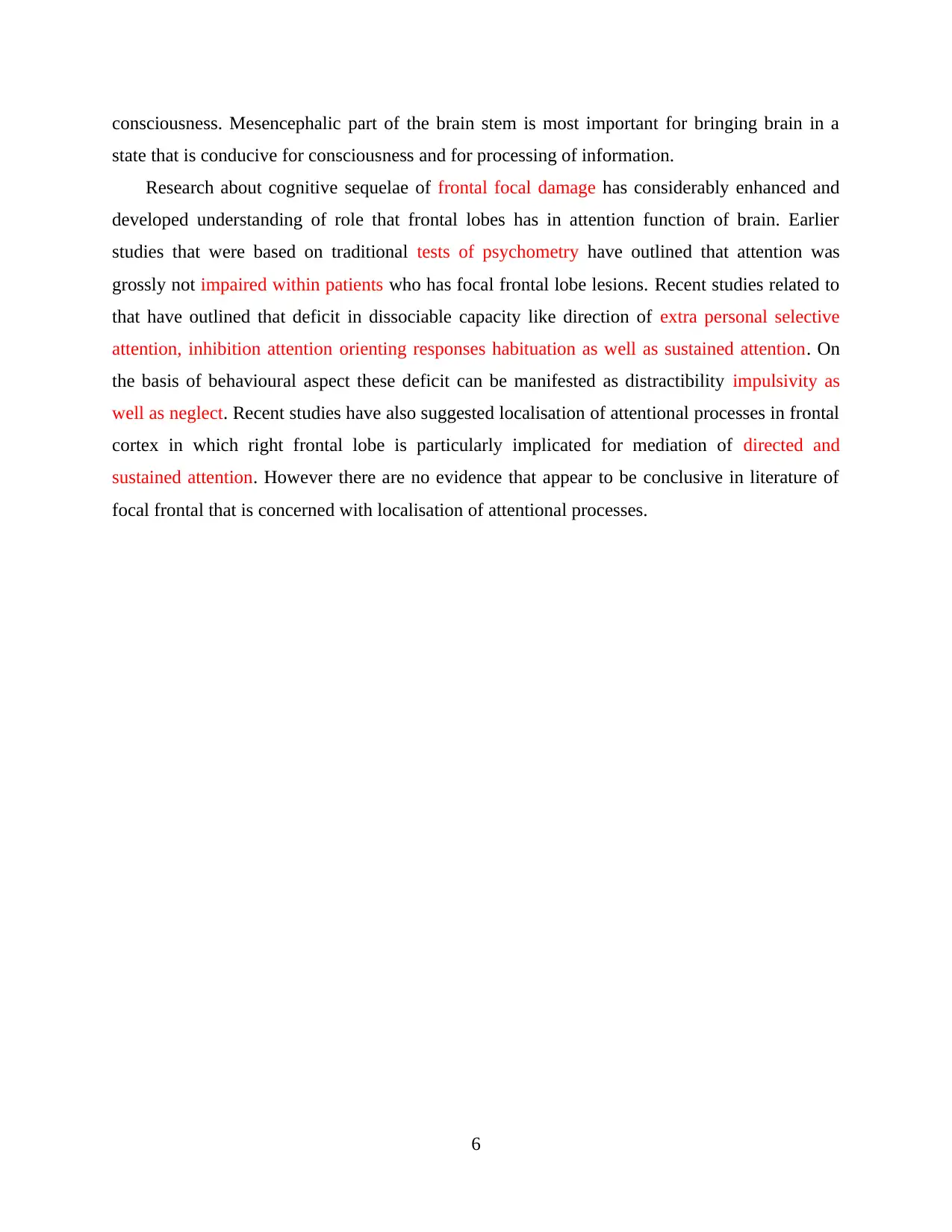
consciousness. Mesencephalic part of the brain stem is most important for bringing brain in a
state that is conducive for consciousness and for processing of information.
Research about cognitive sequelae of frontal focal damage has considerably enhanced and
developed understanding of role that frontal lobes has in attention function of brain. Earlier
studies that were based on traditional tests of psychometry have outlined that attention was
grossly not impaired within patients who has focal frontal lobe lesions. Recent studies related to
that have outlined that deficit in dissociable capacity like direction of extra personal selective
attention, inhibition attention orienting responses habituation as well as sustained attention. On
the basis of behavioural aspect these deficit can be manifested as distractibility impulsivity as
well as neglect. Recent studies have also suggested localisation of attentional processes in frontal
cortex in which right frontal lobe is particularly implicated for mediation of directed and
sustained attention. However there are no evidence that appear to be conclusive in literature of
focal frontal that is concerned with localisation of attentional processes.
6
state that is conducive for consciousness and for processing of information.
Research about cognitive sequelae of frontal focal damage has considerably enhanced and
developed understanding of role that frontal lobes has in attention function of brain. Earlier
studies that were based on traditional tests of psychometry have outlined that attention was
grossly not impaired within patients who has focal frontal lobe lesions. Recent studies related to
that have outlined that deficit in dissociable capacity like direction of extra personal selective
attention, inhibition attention orienting responses habituation as well as sustained attention. On
the basis of behavioural aspect these deficit can be manifested as distractibility impulsivity as
well as neglect. Recent studies have also suggested localisation of attentional processes in frontal
cortex in which right frontal lobe is particularly implicated for mediation of directed and
sustained attention. However there are no evidence that appear to be conclusive in literature of
focal frontal that is concerned with localisation of attentional processes.
6
Paraphrase This Document
Need a fresh take? Get an instant paraphrase of this document with our AI Paraphraser

REFERENCES
Books and Journals
Ballesteros, S. and Mayas, J., 2015. Selective attention affects conceptual object priming and
recognition: a study with young and older adults. Frontiers in psychology. 5. p.1567.
Chai, W.J., Abd Hamid, A.I. and Abdullah, J.M., 2018. Working memory from the
psychological and neurosciences perspectives: a review. Frontiers in psychology, 9,
p.401.
Engle, R. W. (2018). Working memory and executive attention: A revisit. Perspectives on
Psychological Science. 13(2). 190-193.
Lindsay, G.W., 2020. Attention in psychology, neuroscience, and machine learning. Frontiers in
computational neuroscience. 14. p.29.
Mahone, E.M. and Denckla, M.B., 2017. Attention-deficit/hyperactivity disorder: a historical
neuropsychological perspective. Journal of the International Neuropsychological
Society. 23(9-10). pp.916-929.
Medina, J., & Cason, S. (2017). No evidential value in samples of transcranial direct current
stimulation (tDCS) studies of cognition and working memory in healthy
populations. Cortex. 94. 131-141.
Miller, E.K., Lundqvist, M. and Bastos, A.M., 2018. Working Memory 2.0. Neuron, 100(2),
pp.463-475.
Mulders, P and et.al., 2018. Personality profiles are associated with functional brain networks
related to cognition and emotion. Scientific reports. 8(1). pp.1-8.
7
Books and Journals
Ballesteros, S. and Mayas, J., 2015. Selective attention affects conceptual object priming and
recognition: a study with young and older adults. Frontiers in psychology. 5. p.1567.
Chai, W.J., Abd Hamid, A.I. and Abdullah, J.M., 2018. Working memory from the
psychological and neurosciences perspectives: a review. Frontiers in psychology, 9,
p.401.
Engle, R. W. (2018). Working memory and executive attention: A revisit. Perspectives on
Psychological Science. 13(2). 190-193.
Lindsay, G.W., 2020. Attention in psychology, neuroscience, and machine learning. Frontiers in
computational neuroscience. 14. p.29.
Mahone, E.M. and Denckla, M.B., 2017. Attention-deficit/hyperactivity disorder: a historical
neuropsychological perspective. Journal of the International Neuropsychological
Society. 23(9-10). pp.916-929.
Medina, J., & Cason, S. (2017). No evidential value in samples of transcranial direct current
stimulation (tDCS) studies of cognition and working memory in healthy
populations. Cortex. 94. 131-141.
Miller, E.K., Lundqvist, M. and Bastos, A.M., 2018. Working Memory 2.0. Neuron, 100(2),
pp.463-475.
Mulders, P and et.al., 2018. Personality profiles are associated with functional brain networks
related to cognition and emotion. Scientific reports. 8(1). pp.1-8.
7
1 out of 8
Your All-in-One AI-Powered Toolkit for Academic Success.
+13062052269
info@desklib.com
Available 24*7 on WhatsApp / Email
![[object Object]](/_next/static/media/star-bottom.7253800d.svg)
Unlock your academic potential
Copyright © 2020–2025 A2Z Services. All Rights Reserved. Developed and managed by ZUCOL.


